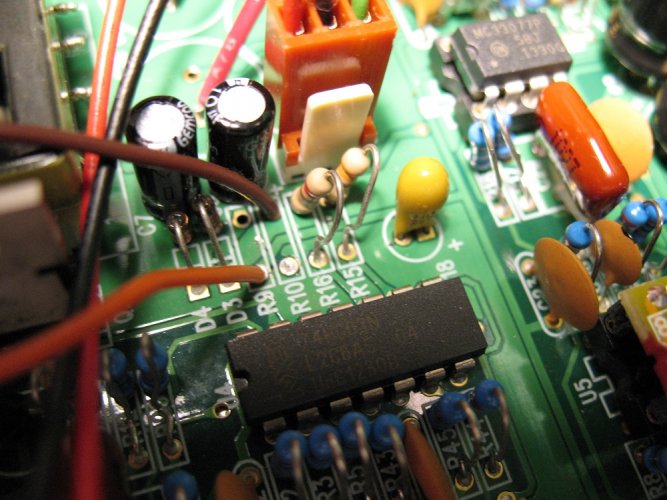starting a thread for E90 related info
*** Post #5: front plate removal
*** Post #30: parts-list for a basic upgrade.
Disclaimer: info might not be complete/accurate; for casual reading / entertainment purpose only
opening the case requires peeling off the thin aluminum face decal, the decal deforms easily so don't attempt this unless you really want to get inside the case..... warming it up first (using a light bulb) helps.

top board has 9 brown film caps, 0.022uf/630v (the one close to the face plate is probably for bias circuit); two opamps, MC33077; two opto isolators H11G1

bottom board:
signal: from the RCA jacks, there are two 1uf input caps, then two TLC2082 opamp (u7/8, forms some kind of buffer) , then two MC33077 opamp (u5/6),
then one TLC2082 (u9), not sure if it is for audio signal or not.
power supply: U2=LM393, U3=TLC27M2CP, U10=TLC27M4CN, U4=74HC02N
** power input reservoir cap C33 is 2200uf/10v (this cap is always connected to the power input jack, whether the amp switch is on or not).
So it is, at least in theory, NOT OK TO USE voltage higher than 10v. However the Koss stock wallward outputs 13.3v no load and 11.2v idle, and C33 will see these voltages as long as the wallward is plugged in.....not sure why C33 survives. Maybe it is super grade stuff.

update: observation, C33:
bought a spare E90, was intending to leave it fully stock but couldn't help myself.... opened it to take a look and found the C33 is popped in this one. It is a massdrop model so can't be that old. it still works fine. I guess it doesn't matter that much after all, might degrade the sound quality a little but likely not noticeable without direct comparison to a fresh E90.

*** Post #5: front plate removal
*** Post #30: parts-list for a basic upgrade.
Disclaimer: info might not be complete/accurate; for casual reading / entertainment purpose only
opening the case requires peeling off the thin aluminum face decal, the decal deforms easily so don't attempt this unless you really want to get inside the case..... warming it up first (using a light bulb) helps.

top board has 9 brown film caps, 0.022uf/630v (the one close to the face plate is probably for bias circuit); two opamps, MC33077; two opto isolators H11G1

bottom board:
signal: from the RCA jacks, there are two 1uf input caps, then two TLC2082 opamp (u7/8, forms some kind of buffer) , then two MC33077 opamp (u5/6),
then one TLC2082 (u9), not sure if it is for audio signal or not.
power supply: U2=LM393, U3=TLC27M2CP, U10=TLC27M4CN, U4=74HC02N
** power input reservoir cap C33 is 2200uf/10v (this cap is always connected to the power input jack, whether the amp switch is on or not).
So it is, at least in theory, NOT OK TO USE voltage higher than 10v. However the Koss stock wallward outputs 13.3v no load and 11.2v idle, and C33 will see these voltages as long as the wallward is plugged in.....not sure why C33 survives. Maybe it is super grade stuff.

update: observation, C33:
bought a spare E90, was intending to leave it fully stock but couldn't help myself.... opened it to take a look and found the C33 is popped in this one. It is a massdrop model so can't be that old. it still works fine. I guess it doesn't matter that much after all, might degrade the sound quality a little but likely not noticeable without direct comparison to a fresh E90.

Last edited:
































